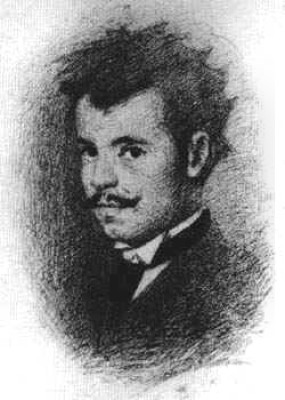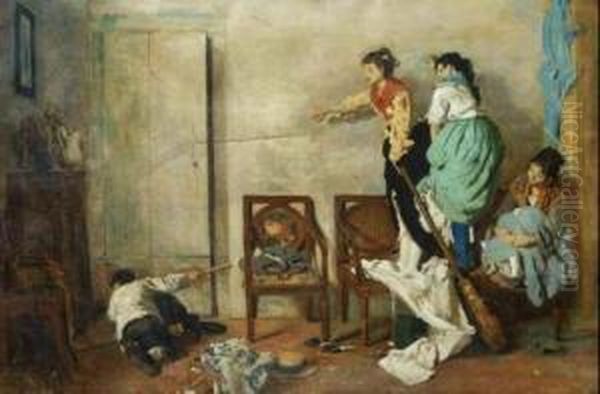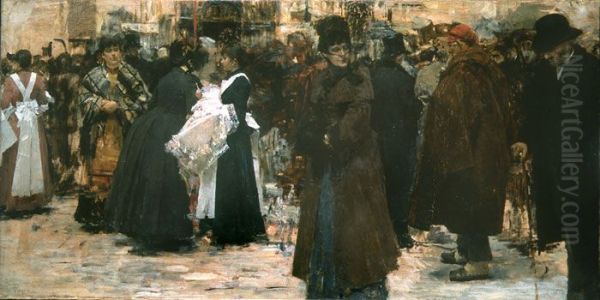
Giacomo Favretto stands as one of the most beloved and significant Italian painters of the latter half of the 19th century. Born in Venice in 1849 and tragically dying young in 1887, his vibrant and detailed depictions of everyday life in his native city earned him widespread acclaim during his lifetime and secured his position as a key figure in the revival of the Venetian School. His work, rooted in Realism, captures the unique atmosphere, light, and character of Venice with affection and keen observation, offering a window into the world of ordinary Venetians during a period of transition.
Humble Beginnings and Artistic Awakening
Giacomo Favretto was born on August 11, 1849, into modest circumstances in Venice. His father, Domenico Favretto, was a carpenter, and his mother, Angela Brunello, worked as a seamstress or weaver. The family's financial situation was often precarious, and young Giacomo grew up amidst the practicalities of his father's workshop. His early life was marked by the need to contribute to the family income, leading him to work for a time in a stationer's shop or possibly a paper mill, rather than pursuing formal education immediately.
Despite these humble beginnings, an artistic inclination began to surface. Sources suggest his father may have initially encouraged his drawing skills. A pivotal moment came through his encounter with Vincenzo Favenza, an antique dealer, or perhaps through interactions within the artistic circles connected to the shop where he worked. Recognizing the young man's talent, support was found to enable him to pursue formal art training, a path that would dramatically alter his life's trajectory.
Education at the Accademia di Belle Arti
In 1864, at the age of fifteen, Giacomo Favretto enrolled in the prestigious Accademia di Belle Arti di Venezia (Venice Academy of Fine Arts). This institution was the inheritor of a long and glorious artistic tradition, but like much of Italian art in the mid-19th century, it was navigating the currents of change, balancing academic tradition with emerging realist tendencies. Here, Favretto received a solid grounding in drawing, composition, and painting techniques.

He studied under several influential masters who shaped his development. Pompeo Molmenti, a respected landscape painter, likely encouraged Favretto's sensitivity to light and atmosphere, fostering a more open approach than strict academicism might have allowed. Michelangelo Grigoletti, a history painter known for his command of color, imparted valuable lessons in chromatic harmony and application, which would become hallmarks of Favretto's mature style. Domenico Brescianini, another figure associated with historical and religious painting at the Academy, also contributed to his formal training.
During his time at the Academy, Favretto proved to be a diligent and talented student. He absorbed the lessons of his teachers but also began to forge his own path, looking closely at the world around him. He formed important friendships with fellow students who would also become notable painters, such as Guglielmo Ciardi, known for his luminous Venetian lagoonscapes. These interactions and shared artistic explorations were crucial in shaping his perspective and ambitions.
The Venetian Artistic Context
To fully appreciate Favretto's contribution, it's essential to understand the Venetian art scene he entered. The dazzling legacy of the 18th century, dominated by figures like Giovanni Battista Tiepolo with his grand decorative schemes and Pietro Longhi with his intimate genre scenes, cast a long shadow. The subsequent periods, marked by political upheaval and Austrian rule, had seen a relative decline in artistic innovation compared to Venice's golden age.
By the mid-19th century, there was a desire to reinvigorate Venetian painting. While academic traditions persisted, new influences were emerging. The broader European movement towards Realism, focusing on contemporary life and unidealized subjects, was gaining traction. In Italy, this manifested in various regional forms, including the Macchiaioli in Florence, led by artists like Giovanni Fattori, who experimented with patches of color ('macchia') to capture light and form. While distinct from Favretto's detailed style, the underlying interest in depicting reality was shared. Favretto's achievement would be to synthesize the Venetian tradition of color and light with this modern realist impulse.
Early Career and the Rise of Realism
Favretto completed his studies around 1870 and quickly began to make a name for himself. His early works showed a strong inclination towards genre painting – scenes of everyday life – rendered with increasing technical skill and a keen eye for detail. He was drawn not to grand historical narratives but to the vibrant, bustling life of Venice's streets, canals, markets, and homes.

A significant breakthrough came in 1873 when he exhibited La lezione di anatomia (The Anatomy Lesson) at the prestigious Brera Academy exhibition in Milan. This painting, depicting a rather informal and perhaps slightly humorous scene within an academic setting, garnered considerable attention for its strong realist character and departure from more conventional subjects. It signaled Favretto's arrival as a distinctive voice in contemporary Italian art.
His style continued to evolve, characterized by bright, clear light, a rich and varied palette, and meticulous attention to textures, costumes, and the specific details of Venetian settings. He was influenced by the technical brilliance and vibrant colorism of the Spanish painter Mariano Fortuny, whose work was highly fashionable across Europe at the time. However, Favretto adapted these influences to his own unique vision, focusing firmly on his native city.
Master of Venetian Genre Painting
The core of Favretto's artistic output lies in his captivating genre scenes. He became the preeminent visual chronicler of late 19th-century Venetian life, capturing its charm, humor, and social nuances. His subjects were drawn from the everyday world he observed: women chatting on balconies, vendors selling their wares in the campi (squares), families gathered in modest interiors, artisans at work, and the leisurely promenades of the bourgeoisie.
Works like Il Sorcio (The Mouse, 1878) exemplify his ability to create engaging narrative vignettes from simple moments. The painting depicts a group of women reacting with varying degrees of alarm and amusement to a mouse, rendered with lively characterization and exquisite detail in the setting and costumes. It showcases his skill in capturing expressions and gestures, bringing his figures to life.
Another important work, Vandalismo (Vandalism, also known as Pola, 1880), earned him the prestigious Prince Umberto prize at the National Exhibition in Turin. This painting, depicting boys mischievously defacing posters, again demonstrates his focus on contemporary incidents and his ability to handle complex multi-figure compositions with anecdotal flair. The setting is rendered with photographic clarity, highlighting his commitment to realism.
Light, Color, and Atmosphere
Favretto's paintings are celebrated for their luminous quality. He masterfully captured the unique light of Venice – the bright sunshine reflecting off water and stone, the softer light filtering through narrow alleyways, the warm glow of interiors. His palette was correspondingly vibrant, employing pure, clear colors applied with confident brushwork that, while detailed, often retained a sense of freshness and spontaneity.
His technique involved careful observation and precise rendering, yet his works rarely feel stiff or overly academic. He imbued his scenes with a palpable atmosphere, conveying the sounds, smells, and social energy of the city. Whether depicting the bustling activity of the Pescheria (fish market) or the quiet intimacy of a domestic scene, Favretto made the viewer feel present in the moment.
Liston Moderno (Modern Stroll or Promenade, 1884) is a prime example of his mature style, capturing the fashionable crowd promenading near Piazza San Marco. The painting is a symphony of light, color, and social observation, depicting the elegant attire and interactions of the Venetian upper-middle class. It reflects not only his technical mastery but also his interest in documenting the social fabric of his time, touching upon themes of modernity within the historic city.
Contemporaries and Connections
Favretto was part of a vibrant generation of Venetian artists who contributed to the city's artistic renewal. He maintained close ties with Guglielmo Ciardi, whose atmospheric lagoon paintings offered a different but complementary vision of the Veneto region. Other notable contemporaries included Federico Zandomeneghi, who, while starting in Venice, would later move to Paris and become associated with the Impressionists, and Luigi Nono (the painter, 1850-1918), known for his poignant genre scenes often tinged with social commentary.
Alessandro Milesi was another significant Venetian genre painter working in a similar vein, often depicting scenes of popular life with warmth and sympathy. Further afield, Favretto's work can be seen in the context of broader Italian Realism (Verismo), which included artists like the Neapolitan Antonio Mancini, known for his psychologically intense portraits, or the aforementioned Macchiaioli group in Tuscany. While Favretto's style remained distinctly Venetian, he was aware of and respected by artists across Italy. His success also resonated internationally, placing him alongside popular European genre painters like the Frenchman Jean-Louis-Ernest Meissonier, admired for his meticulous historical scenes, though Favretto's focus remained firmly on contemporary life.
Recognition and Success
Throughout the 1870s and 1880s, Favretto's reputation grew steadily. He exhibited regularly and successfully in Venice, Milan, Turin, and other Italian cities, as well as internationally, including at the Paris Salon. His paintings were popular with collectors, both Italian and foreign, who were charmed by his lively depictions of Venice, a city that held enduring fascination for travelers.
His works commanded high prices, and he achieved a level of financial success that contrasted sharply with his humble origins. He became a leading figure in the Venetian art world, admired for his technical skill, his appealing subject matter, and his role in revitalizing the local artistic tradition. His paintings were seen as embodying a modern, yet distinctly Venetian, sensibility. Works like I musicanti girovaghi (The Traveling Musicians), praised for its handling of light and cheerful subject matter when shown in Milan in 1881, further cemented his popularity.
Later Years and Untimely Death
Despite his success, Favretto's life was cut tragically short. In the mid-1880s, his health began to decline. Some accounts mention severe eye problems, possibly an infection, which must have been deeply troubling for a painter so reliant on visual acuity. However, his final illness appears to have been more acute. In June 1887, while involved in preparations for the National Art Exhibition in Venice, he contracted a fever, often identified as typhoid fever or a related infection.
His condition worsened rapidly, and Giacomo Favretto died on June 12, 1887, at the height of his career, just shy of his 38th birthday. His premature death was a shock to the Italian art world and a significant loss for Venetian painting. He left behind a substantial body of work, but one can only speculate on how his art might have further evolved had he lived longer.
Legacy and Influence
Giacomo Favretto's legacy is significant. He is widely regarded as the most important Venetian genre painter of the late 19th century and a key figure in the movement often termed Italian Verismo. He successfully blended the Venetian tradition of colorito (emphasis on color and light) with a modern realist sensibility, creating a style that was both technically accomplished and immensely appealing.
His influence was felt by the next generation of Venetian painters, including Ettore Tito, who continued the tradition of depicting vibrant scenes of Venetian life, albeit often with a lighter, more impressionistic touch. Favretto's work helped to keep the Venetian School relevant in an era dominated by artistic developments elsewhere, particularly in Paris.
Today, Favretto's paintings are held in major Italian museums, including the Gallerie dell'Accademia in Venice, the Galleria Nazionale d'Arte Moderna in Rome, and the Pinacoteca di Brera in Milan, as well as in numerous private collections worldwide. His works remain popular for their charm, technical brilliance, and evocative portrayal of a bygone era in Venice. He stands as a testament to the enduring power of observational realism combined with a deep affection for one's native place, forever capturing the spirit of late 19th-century Venice in light and color.